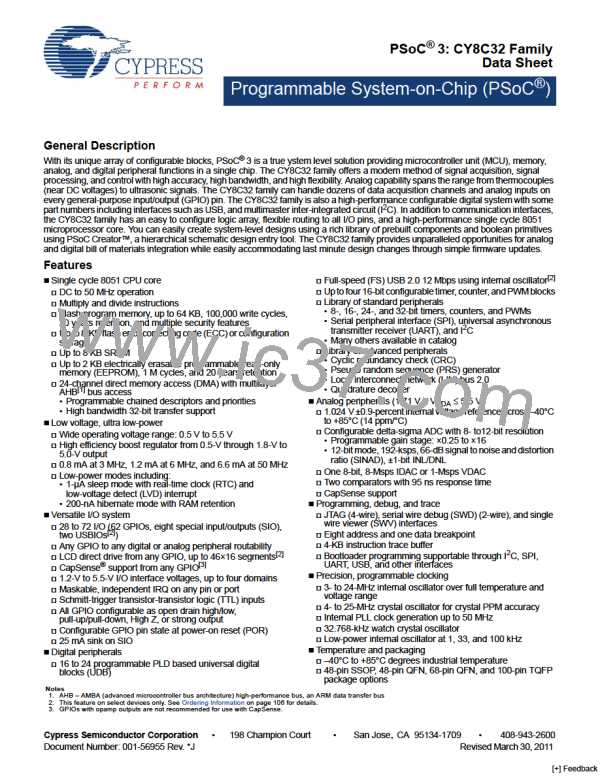PSoC® 3: CY8C32 Family
Data Sheet
9.2 Serial Wire Debug Interface
9. Programming, Debug Interfaces,
Resources
The SWD interface is the preferred alternative to the JTAG
interface. It requires only two pins instead of the four or five
needed by JTAG. SWD provides all of the programming and
debugging features of JTAG at the same speed. SWD does not
provide access to scan chains or device chaining. The SWD
clock frequency can be up to 1/3 of the CPU clock frequency.
PSoC devices include extensive support for programming,
testing, debugging, and tracing both hardware and firmware.
Three interfaces are available: JTAG, SWD, and SWV. JTAG and
SWD support all programming and debug features of the device.
JTAG also supports standard JTAG scan chains for board level
test and chaining multiple JTAG devices to a single JTAG
connection.
SWD uses two pins, either two of the JTAG pins (TMS and TCK)
or the USBIO D+ and D– pins. The USBIO pins are useful for in
system programming of USB solutions that would otherwise
require a separate programming connector. One pin is used for
the data clock and the other is used for data input and output.
SWD can be enabled on only one of the pin pairs at a time. This
only happens if, within 8 µs (key window) after reset, that pin pair
(JTAG or USB) receives a predetermined sequence of 1s and 0s.
SWD is used for debugging or programming the flash memory.
Complete Debug on Chip (DoC) functionality enables full device
debugging in the final system using the standard production
device. It does not require special interfaces, debugging pods,
simulators, or emulators. Only the standard programming
connections are required to fully support debug.
The PSoC Creator IDE software provides fully integrated
programming and debug support for PSoC devices. The low cost
MiniProg3 programmer and debugger is designed to provide full
programming and debug support of PSoC devices in conjunction
with the PSoC Creator IDE. PSoC JTAG, SWD, and SWV
interfaces are fully compatible with industry standard third party
tools.
The SWD interface can be enabled from the JTAG interface or
disabled, allowing its pins to be used as GPIO. Unlike JTAG, the
SWD interface can always be reacquired on any device during
the key window. It can then be used to reenable the JTAG
interface, if desired. When using SWD or JTAG pins as standard
GPIO, make sure that the GPIO functionality and PCB circuits do
not interfere with SWD or JTAG use.
All DOC circuits are disabled by default and can only be enabled
in firmware. If not enabled, the only way to reenable them is to
erase the entire device, clear flash protection, and reprogram the
device with new firmware that enables DOC. Disabling DOC
features, robust flash protection, and hiding custom analog and
digital functionality inside the PSoC device provide a level of
security not possible with multichip application solutions.
Additionally, all device interfaces can be permanently disabled
(Device Security) for applications concerned about phishing
attacks due to a maliciously reprogrammed device. Permanently
disabling interfaces is not recommended in most applications
because you cannot access the device later. Because all
programming, debug, and test interfaces are disabled when
Device Security is enabled, PSoCs with Device Security enabled
may not be returned for failure analysis.
9.3 Debug Features
Using the JTAG or SWD interface, the CY8C32 supports the
following debug features:
Halt and single-step the CPU
View and change CPU and peripheral registers, and RAM
addresses
Eight program address breakpoints
One memory access breakpoint—break on reading or writing
any memory address and data value
Break on a sequence of breakpoints (non recursive)
Debugging at the full speed of the CPU
Table 9-1. Debug Configurations
Debug operations are possible while the device is reset, or in
low-power modes
Debug and Trace Configuration
GPIO Pins Used
CompatiblewithPSoCCreatorandMiniProg3programmerand
debugger
All debug and trace disabled
0
JTAG
4 or 5
Standard JTAG programming and debugging interfaces make
CY8C32 compatible with other popular third-party tools (for
example, ARM / Keil)
SWD
2
1
3
SWV
SWD + SWV
9.4 Trace Features
The CY8C32 supports the following trace features when using
JTAG or SWD:
9.1 JTAG Interface
The IEEE 1149.1 compliant JTAG interface exists on four or five
pins (the nTRST pin is optional). The JTAG clock frequency can
be up to 8 MHz, or 1/3 of the CPU clock frequency for 8 and 16-bit
transfers, or 1/5 of the CPU clock frequency for 32-bit transfers,
whichever is least. By default, the JTAG pins are enabled on new
devices but the JTAG interface can be disabled, allowing these
pins to be used as General Purpose I/O (GPIO) instead. The
JTAG interface is used for programming the flash memory,
debugging, I/O scan chains, and JTAG device chaining.
Trace the 8051 program counter (PC), accumulator register
(ACC), and one SFR / 8051 core RAM register
Trace depth up to 1000 instructions if all registers are traced,
or 2000 instructions if only the PC is traced (on devices that
include trace memory)
Program address trigger to start tracing
Trace windowing, that is, only trace when the PC is within a
given range
Two modes for handling trace buffer full: continuous (overwriting
the oldest trace data) or break when trace buffer is full
Document Number: 001-56955 Rev. *J
Page 59 of 119
[+] Feedback

 CYPRESS [ CYPRESS ]
CYPRESS [ CYPRESS ]